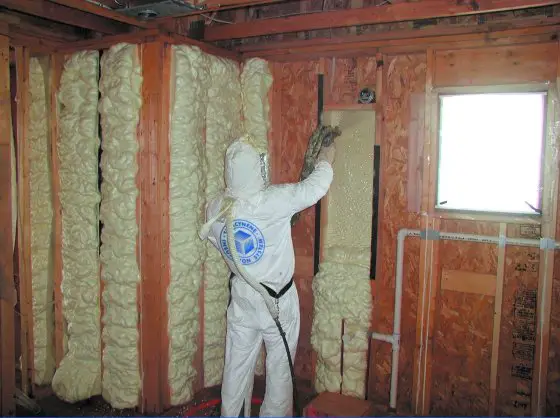Foam Insulation

Foam insulation fills every nook and cranny in a wall. It is typically installed by professionals and can be messy to work with. It is not really a do-it-yourself job. PHOTO CREDIT: Icynene. Inc.
Spray Foam Insulation
DEAR TIM: Is foam insulation as good as the manufacturers claim? Is 2 1/2 inches of foam better than 5 1/2 inches of fiberglass? Is it necessary to install 2x6 walls if you only need 2.5 inches of foam insulation? What about spraying the foam directly to the roof? I've heard if you use this on the underside of the roof instead of fiberglass insulation blown on the attic floor, you don't need to do ventilation under the roof? Is this true? Does it make financial sense to use it? Dan J., Cedar Rapids, IA
DEAR DAN: I used spray foam insulation on a job of mine about 20 years ago. A customer who owned a poultry slaughterhouse insisted on it as he used spray foam insulation in his refrigeration delivery trucks and on certain walls at the actual meat processing plant.
Back then at least in my neck of the woods, foam insulation was a commercial product and it was tough to locate an installer who would spray it in the wall studs of a home. Although I can't prove it, I might have been the first contractor in Cincinnati, OH to install foam insulation in a residential home. The person who did the installation told me at the time he had never heard of it being installed in a home before.
How does spray foam compare to fiberglass insulation?
Spray foam insulation is a superb product. As far as comparing thickness of foam to fiberglass, that is a simple comparison on a product-by-product basis. You need independent test results that confirm what the R-value is per inch of thickness of a given product. R-value is a measurement of thermal efficiency; it is a measurement the resistance to heat flow. The higher the R-value number the greater resistance the insulation has to the movement of heat.
Learn the secrets for successfully installing insulation with my Insulation Installation Checklist. I offer a 100% Money Back Guarantee.
So if you want a given R-value, then you simply specify a given finished thickness. Typically closed cell foam products produce a higher R-value per inch than batts of fiberglass.
Do wall studs affect the insulation?
As for wall thickness, there are other considerations such as plumbing stacks, wind loads, concentrated loads, etc. I believe that the wall stud you should use has nothing to do with the insulation. You will need to install whatever wall stud that meets the structural and mechanical needs of the home. Wall cavities do not have to be totally filled with foam insulation to perform well.
Because foam insulation typically can be significantly more expensive than fiberglass or cellulose insulation, you need to determine if it makes good financial sense to invest in it. If you install it and it has the same finished R-value as fiberglass and/or cellulose, then your heating and cooling bills will be almost identical. This means that it does not makes sense to install it as you save nothing to heat and cool your home.
Remember, your furnace and air conditioner can't see what is in the walls, but they do know what the total heat gain and heat loss of the house is. Yes, the foam insulation can cut down on air infiltration. But a properly installed house wrap and a case or two of caulking can do nearly the same.
How do you save money on heating and cooling costs?
To save lots of money on heating and cooling costs, you must significantly lower your overall heat gain and heat loss. This is accomplished by decreasing the size of your home or increasing significantly the R-value of the home's insulation.
But increasing R-value is not a silver bullet. As you add more insulation, the heat gain and heat loss does not respond in a linear fashion. It doesn't take long to reach a point of diminishing returns.
So before you make up your mind, talk with your HVAC contractor and ask him what the wall R-values of any insulation must be to significantly cause a reduction in the size of the furnace or air conditioning unit. That calculation takes just minutes to do.
Need help with the R-values of insulation? CLICK or TAP HERE to get FREE QUOTES from local companies that can insulation your house.
Once you have projected heat-loss and heat-gain calculations, you can then ask the foam insulation contractor how much it will cost to hit that target. Then start doing the math. See how much you save initially on the cost of the smaller furnace and air conditioning unit. Then see how much extra the foam insulation costs versus traditional fiberglass or cellulose.
Finally, ask your local utility company to see if it can project what the cost to operate different-sized heating and cooling equipment might be over a five-year period. Do the addition, subtraction and multiplication and see where you end up.
Column 565
One Response to Foam Insulation